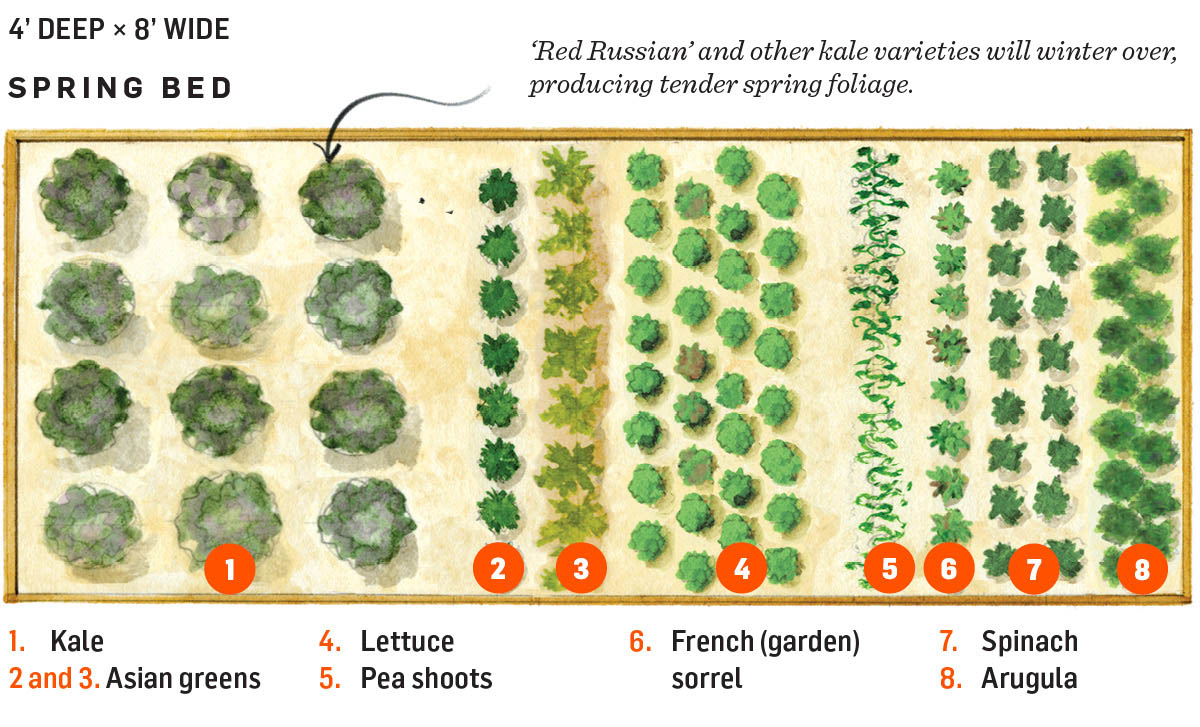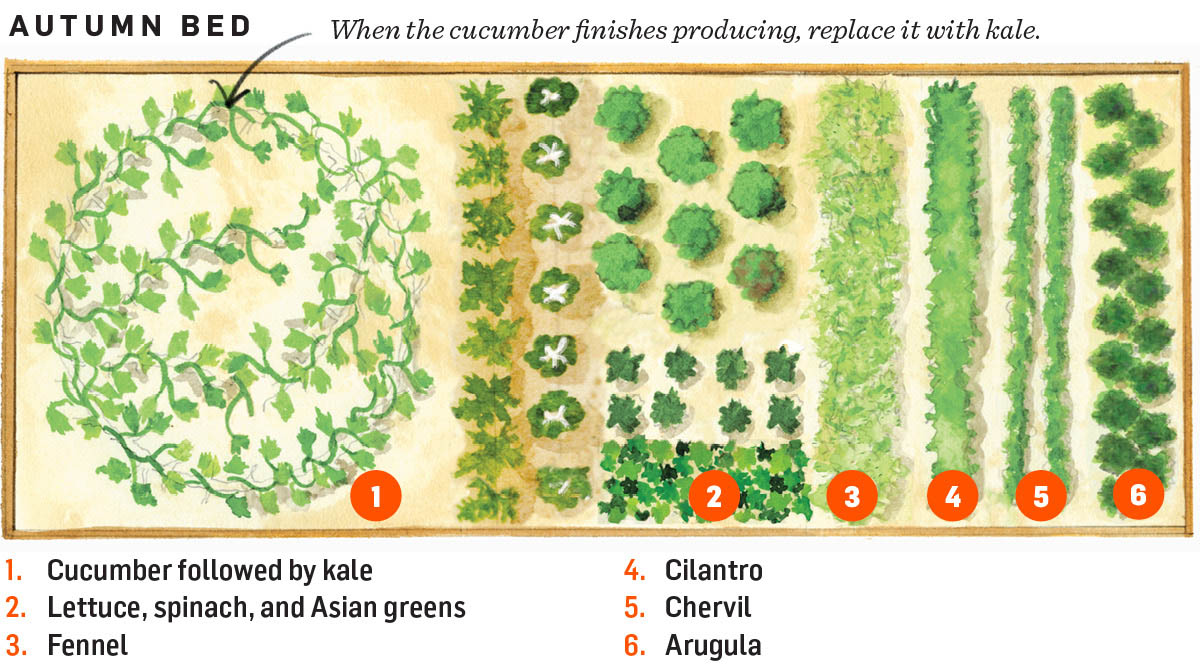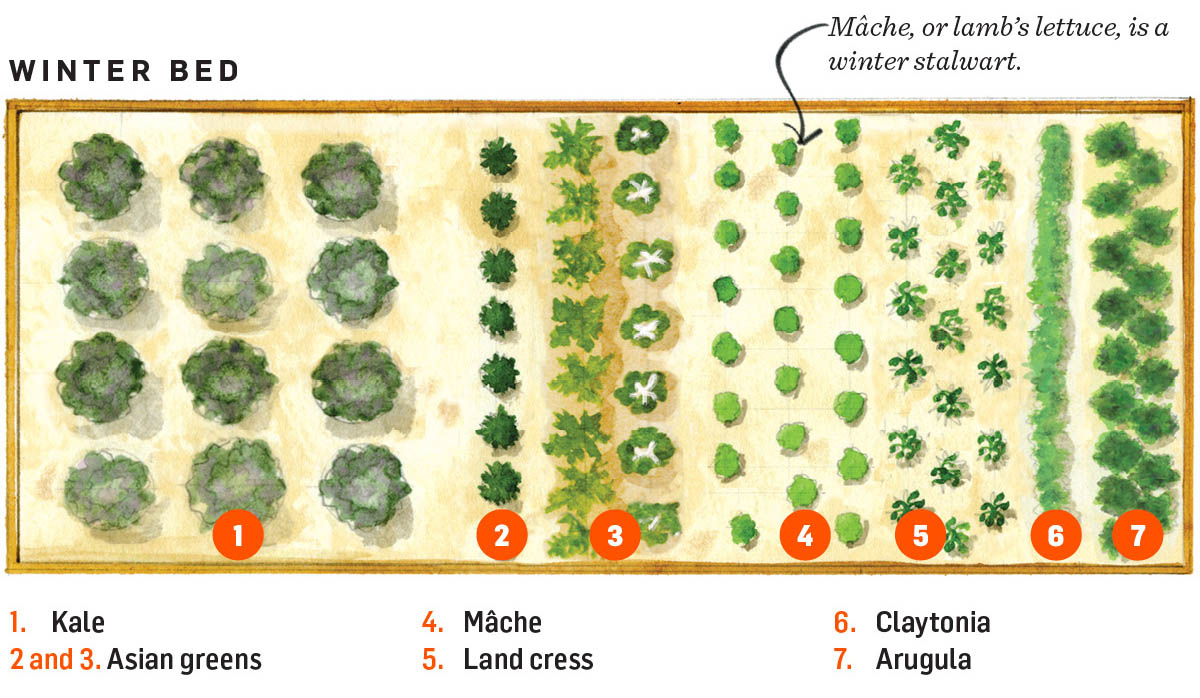
A garden doesn’t have to be large to be productive, as demonstrated by Michelle Chapman’s modest 4- by 8-foot plot that provides a steady supply of leafy crops for every week of the year. Michelle matches her crops to the season, opting for heat-tolerant salad ingredients in summer and cold-resistant ones in winter. Even on those days when driving rain or plunging temperatures keep you indoors, your salad bowl shouldn’t be empty. Michelle’s solution? Microgreens or sprouts!
In late 2011, award-winning garden blogger Michelle Chapman turned her attention to a new project: The 52-Week Salad Challenge. She and many other bloggers and gardeners from around the world decided to try to encourage more people to grow some of their own food. As the year progressed, they regularly shared their successes and failures on their blogs. “The main idea was that we all would grow and/or forage some salad leaves to eat every week that year,” she says. The types of greens that were cultivated varied by gardener, since crop selection depends on location, taste preference, skill level, and available garden space.

Never go greens-less. To celebrate the spirit of the 52-week challenge, Michelle has created a salad plot that measures just 4 by 8 feet but yields a continuous parade of favorite salad crops, supplemented by Michelle’s foraging suggestions and a few potted salad essentials like cherry tomatoes, herbs, and edible flowers.
Winter tunnel. For winter protection, a simple mini hoop tunnel or tunnel cloche can be erected over the bed in late autumn, before the hard frosts. Use 1/2-inch PVC pipe for the hoops and cover with a clear polycarbonate material, securing well with clips or weighting down with rocks, logs, or bags of soil. To harvest in winter, simply lift the plastic cover and take what you need.

1. Kale. When the plants bolt in late spring, the broccoli-like flower buds can be gathered and eaten raw or lightly cooked. If the buds are allowed to open, the cheerful yellow blooms can be tossed in salads. Michelle suggests sowing a few quick-growing root crops such as radishes or beets around the kale in early spring.
2 and 3. Asian greens. In Zones 5 and above, the leaves of the Asian greens from winter will still be growing strong in early spring but will soon bolt, so Michelle suggests sowing a fresh batch of mizuna.
4. Lettuce. Start seeds indoors in February in flats or pots and move the plants to the garden in early spring. Protect them with a row cover or cloche, and you’ll be harvesting by April. Try planting them in a grid pattern to get the most out of your space.
5. Pea shoots. “They add a lovely, fresh pea taste in early spring and crop relatively quickly,” says Michelle, adding that they can also be grown indoors in pots over the winter.
6. French (garden) sorrel. A small planting of sorrel will add a punch of lemon flavor to your salads. “I love the shape of ‘Buckler Leaf’ sorrel, and red-veined sorrel adds pleasing color to the salad bowl,” Michelle says.
7. Spinach. Spinach grows well in the cool, damp weather of spring. “I grow baby leaves rather than full-grown, and I particularly like ‘Apollo’,” Michelle says. “Another is ‘Bordeaux’, which has lately been renamed ‘Red Cardinal’ and has lovely crimson stems and leaf veins.”
8. Arugula. “I prefer wild arugula for its more peppery flavor and longer cropping,” notes Michelle. Once the plants bolt, she adds the flowers to salads.
On the side. Supplement with a large pot of violas, whose flowers add color to salads, and forage for young dandelion leaves and hairy bittercress. “They add interesting flavors to a salad,” says Michelle.

1. Cucumbers and snow peas. Two ‘Marketmore 76' cucumbers (which “will probably spill over the allotted space!”) are planted around the base of a teepee of ‘Oregon Sugar Pod’ or ‘Shiraz’ snow peas (“a fab new purple-podded variety”). Michelle suggests winding the plants around the teepee as they grow. Other cucumber varieties she enjoys include ‘Diva’, ‘Crystal Apple’, and ‘Cornichon de Paris’.
2. Lettuce. Some of Michelle’s favorites include ‘Little Gem’, ‘Red Salad Bowl’, ‘Freckles’, ‘Lolla Rossa’, and ‘Lollo Bionda’. When you pick leaf lettuces, harvest the outside leaves, leaving the central core to grow, she advises. “This allows the lettuces to crop over many months without running to seed.”
3. Arugula. Also called rocket or roquette for its rapid growth, arugula is very easy to grow and ready to harvest after just 30 days, depending on the variety. Quick-growing regular garden arugula has deep green, strappy leaves with a peppery zip, while wild types like ‘Sylvetta’ are slower-growing with smaller, finely cut foliage.
4–6. Various herbs. Michelle’s favorite salad herbs are basil (“I particularly like Greek basil — it has smaller leaves which can be snipped into salads”), an anise-flavored herb such as fennel or chervil, and cilantro, which she allows to go to seed at the end of the season to produce coriander.
On the side. Supplement with a large pot of nasturtiums, which have edible leaves, flowers, and seeds, and a pleasing watercress-like flavor. “If space is tight, nasturtiums can be grown vertically and left to trail down,” she says. She favors ‘Empress of India’ (mounding) or ‘Jewel of Africa’ (trailing).
Michelle also recommends a big pot planted with cherry tomatoes. “My favorites are ‘Gardener’s Delight’ and ‘Sungold’, but ‘Tumbler’ is great for a hanging basket,” she says.

1. Cucumber followed by kale. “The cucumber from the summer will keep going until the first frosts, though the last fruits will be smaller,” warns Michelle. “Replace it with kale plants started in flats or pots.”
2. Lettuce, spinach, and Asian greens. Harvest the summer lettuce until it bolts to seed or turns bitter. As this happens, those rows can be cleaned out and sown with quick-growing, heat-tolerant Asian greens such as pak choi. Once the summer heat fades you can start sowing spinach. In early autumn, sow Asian mustard greens and mizuna for winter harvest.
3. Fennel. “I love bulb fennel at this time of the year,” raves Michelle, who says that she has better success with late sowings of bulb fennel than the standard May planting. “The thinnings, the leafy fronds, and the bulb itself are all good in salads, and I particularly like ‘Zefa Tardo’.” ‘Colossal’ is a variety that Michelle often sows at the end of August for good-sized bulbs by late October.
4. Cilantro. For the longest-lasting harvest, stick to bolt-resistant types like ‘Confetti’ or ‘Slow-bolt’. In the autumn, “I can usually manage a quick crop of cilantro if the weather stays warm like it has done in the past few years,” she says.
5. Chervil. This hardy herb will winter over with a little protection in Zones 5 and above. For colder zones, Michelle suggests cold-tolerant claytonia (winter purslane) as an alternative.
6. Arugula. Choose a wild type like ‘Sylvetta’, which is slower to bolt than regular arugula.
On the side. Michelle keeps a big pot of parsley handy in winter, preferring the flat-leaved type. “This can be moved indoors toward the end of autumn for continued cropping,” she says. To provide carrot leaves and roots for autumn and winter, she sows seed in a pot in late summer. “Carrot leaves can be used as another mild-tasting leaf for salads,” adds Michelle. “A friend also makes a great carrot-top pesto, just as you would with basil!”


1. Kale. Michelle grows ‘Red Russian’ kale, which winters over in many areas of the United States, Canada, and the United Kingdom. As an alternative to ‘Red Russian’, you can grow the heirloom kale ‘Lacinato’ (‘Nero di Toscana’) for use in salads, but Michelle recommends picking it when small for the highest-quality greens. Gardeners in Zones 4 and below need to protect their winter kale and other greens with a mini hoop tunnel.
2 and 3. Asian greens. Mizuna is a favorite for its mild taste and lacy texture, and mustards such as ‘Green Frills’ and ‘Red Giant’ add a nice hot flavor. “I’m also trying tatsoi and komatsuna (Japanese mustard spinach) for the first time this year,” she says. Michelle likes to sow the seed indoors in long, thin styrofoam trays for later transplanting to the garden.
4. Mâche. Also known as lamb’s lettuce or corn salad, Michelle says lamb’s lettuce was “the first of my winter stalwarts!” Michelle uses it as a “salad-building agent” and advises adding flavorful Asian mustards or land cress to the salad bowl to liven up the lamb’s lettuce. She says “the leaves are rather small, hence the slightly larger area devoted to this crop.”
5. Land cress. Also known as American cress, land cress is Michelle’s “absolute winter favorite,” she raves. “I love its peppery taste and almost indestructibility in winter.”
6. Claytonia. Also known as miner’s lettuce or winter purslane, claytonia is a North American native. It is an extremely cold-tolerant salad crop with a spinachlike flavor and succulent leaves. In late winter, tiny edible flowers will emerge and can be tossed in salads for added interest.
7. Arugula. For a winter crop, stick to the hardiest types of arugula. These include ‘Sylvetta’, ‘Ice-Bred’, and ‘Astro’.
For a nutritional punch, Michelle recommends planting some sprouts (germinated seeds) and microgreens (tiny forms of young edible greens) indoors on a south-facing windowsill. “They crop in just days, so they are a great emergency standby, and the seeds add crunch, and the microgreens intense bursts of flavor,” she says.
For sprouting, she suggests mung beans (bean sprouts), chick peas, and alfalfa. For flavorful microgreens she proposes radish, leeks, and coriander.